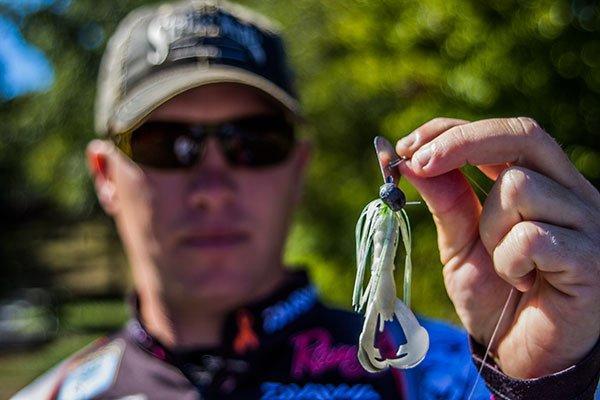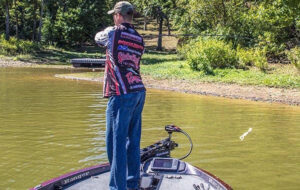Bladed swim jigs are proven bass-catchers throughout the country. When the bite is tough and more traditional lures won’t cut it, bladed swim jigs are often at their best.
Pro Andy Montgomery is in his ultimate comfort zone with a bladed swim jig on the end of his line. According to him, there are 6 reasons you need to be throwing a bladed swim jig the next time you go bass fishing.
- Effective throughout the entire year
- Not just a shad imitation
- You can use it like a squarebill crankbait
- Simple to use
- Excels in dirty water
- Simple color and trailer selection
It catches bass all year
Many bass fishing lures and techniques are very season-specific. Just like the tools in a mechanic’s toolbox, there is a certain time and place to use most lures. Bladed swim jigs, however, can be a very versatile tool in your tackle box.
“Bladed swim jigs, such as the Strike King Tour Grade Rage Blade Swim Jig are very much a year-round bait for me,” Montgomery said. “You can imitate so many of a bass’ primary forage types with it—it doesn’t paint you into a corner by only imitating a single food source.”
Although Montgomery has caught big bass on the Rage Blade throughout the entire year, there are three seasonal periods in which he does his most damage with it.
- Fall: ”The autumn months are all about the bait and a shad-colored Rage Blade is an excellent way to catch pressured fall bass off-guard,” Montgomery said. “Most anglers are going to target these fish with the same type of lures— crankbaits, topwaters, jerkbaits and so on. The Rage Blade gives the bass something totally different from everything else out there. Fall bass get educated quickly and differentiating your presentation will give you a huge advantage.”
- Prespawn: ”Something about the prespawn and a bladed swim jig is just incredible,” Montgomery said. “It catches giant bass on staging areas adjacent to spawning flats. Whether you’re concentrating on rocks, docks or stumps, the big ones don’t hesitate to attack it.
- Post-spawn: ”When the females come off the beds after the spawn, they’re worn out and ready to eat,” Montgomery said. “The Rage Blade has a fairly large profile, which is perfect for these hungry bass. Fish it around the same places in which you targeted prespawners, except in reverse-order and you’ll have great results.
Imitates a wide array of bass forage
The large majority of bass lures are meant to imitate very explicit types of bass forage. Instead of limiting the number of bass to which your lure appeals, bladed swim jigs can attract bass focusing on various food sources.
- Shad: “When bass are feeding on shad, I like to use the Rage Blade in areas where other folks would throw a shallow or medium-depth crankbait,” Montgomery said. “Its larger profile appeals to big bass, so it’s a great way to catch big, kicker fish in tournament situations.”
- Crawfish: ”When a crawfish is trying to evade a threat, it swims and violently kicks itself backward,” Montgomery said. “If you know the bass are eating crawfish, keep the Rage Blade close to the bottom and let it bump into wood and rocks. When you put a Strike King Rage Tail Craw on the back of it, bass will think it’s a panicked crawfish trying to escape, which is when their predatory instincts kick in.”
- Bream: ”Big bass have a hard time passing on a bream,” Montgomery said. “A green bladed swim jig is a great way to imitate bream. It puts off a lot of ‘thump’ much like a bream and when you fish it around shallow cover and underneath docks, you’re going to get some big bites.”
Swim it through the thick stuff
Squarebill crankbaits are a popular choice among bass anglers when fishing shallow cover such as laydowns, stumps and dock posts. Instead of targeting these shallow bass with the same presentation day-in and day-out, Montgomery believes a change in profile can catch the fish others leave behind.
“You can fish the Rage Blade in areas where many squarebills can’t reach,” Montgomery said. “Strike King designed it with the lead head below the blade, so it very rarely gets snagged on heavy cover. No matter how good your squarebill is,
Profile differentiation can also pay big dividends when targeting shallow resident fish. In many fisheries, select bass will live their entire lives in shallow sloughs and backwater areas. They may seem easy to catch, but they can prove to be quite challenging. They’ve probably seen hundreds of crankbaits throughout the year, but there’s a very low possibility they’ve seen many bladed swim jigs swim by their noses.
Simple to use, even for novice anglers
As with most presentations, experimentation with a bladed swim jig’s cadence and retrieve speed is essential to maximizing your success. There’s good news, though— it’s usually not rocket science.
Standard retrieve – “There isn’t one ‘set’ retrieve that’s going to work all day, every day,” Montgomery said. “Most often, however, I just make a long cast and reel it at a medium speed while incorporating a few rod twitches
Recommended Gear
- Rod: 7-foot, 2-inch medium-heavy Daiwa Tatula Casting Rod
- Reel: 6.3:1 Daiwa Tatula 100 Casting Reel
- Line: 20-pound Seaguar InvizX Fluorocarbon Line
“I change things throughout my retrieve—you’ll catch plenty this way. Always pay attention to exactly what you were doing when you got your last bite because that’s the easiest way to develop a strong pattern.”
- Watch the water temperature – “When the water temperature dips down into the 50-degree range, you’ll get a lot more bites fishing the Rage Blade very slowly,” Montgomery said. “As the water warms up, slowly increase your retrieve speed until you find one that works. When it’s cold, the bass aren’t going to be very aggressive, so slower speeds are more appealing. In warmer water, their metabolism becomes faster and they’re going to be more aggressive.”
- Slow your roll – “I get some of my biggest bites when I’m just barely reeling it,” Montgomery said. “A lot of the times I want to barely feel the blade vibrating as it collides into any available cover. You know you’ve got one when it starts to get heavy.”
- Be patient. – “You’re not going to get many bites burning a bladed swim jig like you would a spinnerbait,” Montgomery said. “It think it takes away from the slow, enticing ‘thump’ it emits, so it’s important to be patient and avoid reeling it too fast.”
Dirty water isn’t a problem
Many bass anglers loathe dirty water conditions. The bass can get super-tight to cover and are less apt to give chase to lures, making the bite tough at times. Bladed swim jigs, however, are at their best in low-visibility water.
“You’ll definitely catch fish on a bladed swim jig in clear water, but it really shines in stained water,” Montgomery said. “You don’t really want tomato soup-colored water, but anything less generally isn’t a problem. The Rage Blade is a really
Get better hooksets
Montgomery suggests setting the hook at a 45-degree angle. This angle helps pop the hook point into the hardest part of the bass’ mouth.
“It’s a loud bait with a lot of vibration—just like you’d use a Colorado blade on a spinnerbait in dirty water for added displacement. This is a technique that can definitely help you take advantage of conditions other anglers may hate.”
In addition to stained water, Montgomery also believes wind helps a bladed swim jig bite. Not only will wind stir up oxygen levels in the water, but it also allows him to get up close and personal.
“Wind is great for this technique because you can put the Rage Blade right on top of a fish without spooking it,” Montgomery said. “In calm water bass are much more wary but wind breaks up the surface and makes them less aware of your casts.”
Simple selection process
Some anglers have dozens of color selections for the same lure, but that’s certainly not the case with Montgomery. Although he’s widely renowned as an aficionado of bladed swim jigs, he keeps his color selection insanely simple.
- Chartreuse Sexy Shad – “When the bass are eating shad, it’s very hard to beat a Chartreuse Sexy Shad-colored Rage Blade,” Montgomery said. “The white is a great shad imitation color while the chartreuse helps it stand out a bit more in off-colored water. I usually throw this color more than any other color.”
- Black/Blue – “In the spring, darker colors seem to work much better for me,” Montgomery said. “My color selection doesn’t have as much to do with clarity as you’d think because I’m going to primarily use it in stained water anyway. In any type of lowlight conditions, especially in the spring, it’s hard to beat a black and blue color.”
- Green Pumpkin Craw – “This color is outstanding when you’re fishing around a lot of bream,” Montgomery said. “In the late spring and early summer, bream flood the shallows and big bass will gorge on them. It also imitates a crawfish very well, so I’ll also use this color when I’m around a lot of rocks.”
Similar to his color selection process, Montgomery suggests keeping your soft plastic trailer selection simple as well. More often than not, there are only three types of trailers he uses.
- Crawfish trailer – “The all-around best trailer for bladed swim jigs is a Strike King Rage Tail Craw,” Montgomery said. “You can use a green one to imitate crawfish and also bream because it’s pinchers kick so violently. For clear water, I use a white Rage Tail Craw for the same reason—if you’re steadily reeling it, the fish can’t tell it’s a crawfish trailer and will mistake it for a shad.”
- Twin -tail trailer – “In clear water, I’ll actually use the twin-tail trailers that come on the Rage Blade,” Montgomery said. “They’re not as bulky or threatening and they’re less likely to scare clear water bass.”
- Swimbait – “When I’m looking for a big bite in clear water, I’ll remove the skirt of the Rage Blade and replace it with a Strike King KVD Perfect Plastic Swim’n Caffeine Shad,” Montgomery said. “It’s very natural-looking to fool the bigger, smarter bass but it still has enough bulk to entice a big bite.”
If you’re looking for a new way to catch big bass, consider using a bladed swim jig this year. Instead of using a more traditional presentation, go against the grain for some great—and exciting—results.
What’s your favorite way to fish a bladed swim jig?













